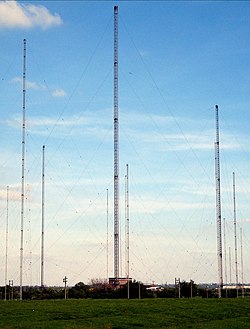Rugby Radio Station
This article needs additional citations for verification. (May 2019) |
 A view of the tallest masts in 2005. | |
 Rugby Radio Station (Warwickshire) | |
| Location | Hillmorton, Rugby, Warwickshire |
|---|---|
| Mast height | 250 metres (820 ft) |
| Coordinates | 52°21′57″N 1°11′21″W / 52.36577°N 1.18928°WCoordinates: 52°21′57″N 1°11′21″W / 52.36577°N 1.18928°W |
| Grid reference | SP5519574542 |
| Built | 1926 |
| Demolished | 2007 |
Rugby Radio Station was a large radio transmission facility at Hillmorton near the town of Rugby, Warwickshire in England, situated just west of the A5 trunk road and in later years junction 18 of the M1 motorway. Part of the site was on the other side of the A5, across the border in Northamptonshire. First opened in 1926, at its height in the 1950s it was the largest radio transmitting station in the world, with a total of 57 radio transmitters, covering an area of 1600 acres. Traffic slowly dwindled from the 1980s onwards, and the site was closed between 2003 and 2007.[1]
History[]
Following the end of the First World War the British government set about implementing plans for an Imperial Wireless Chain to link the countries of the British Empire. It was decided that the new wireless service would be state-run by the Post Office. The site east of Hillmorton, was chosen in 1923. Part of the site had previously been occupied by RAF Lilbourne between 1915 and 1920.[1]
Its large very low frequency (VLF) transmitter came into service on 1 January 1926 and was originally used to transmit telegraph messages to the Commonwealth as part of the Imperial Wireless Chain. After the 1950s this transmitter, active as callsign GBR on 16.0 kHz, using Morse code and later on 15.975 kHz with frequency-shift keying FSK and minimum-shift keying MSK, was used for transmitting messages to submerged submarines. Criggion radio station acted as a reserve. The GBR transmitter was shut down on 1 April 2003 and was replaced by a new one at the Skelton transmitting station. [2]

In 1927, a second transmitter was installed to initiate the first transatlantic commercial telephone service; linking New York and London[3] on 60 kHz using single-sideband modulation. This transmitter was decommissioned in 1956 and became the time signal transmitter MSF. This new function developed from the decision, in 1951, to use the station to transmit modulated standard frequencies for scientific reference purposes. In 1972 these transmissions were consolidated onto the present frequency of 60 kHz and a further reference, that of a time signal, was added. In 1977 this took the form of the rolling slow code in use until April 2007, when BT's contract to transmit the time signal also passed to VT Communications, using their Anthorn radio station in Cumbria. [4] The aerial system at the VLF transmitter existed between 1926 and 2004 and consisted of twelve 250 metre (820 ft) high, guyed steel-framework masts insulated against ground and carrying an aerial wire. This wire was mainly destroyed by heavy iceloads in the winter of 1940. After the shutdown of GBR, the facility was only used for transmitting the MSF time signal. Therefore, eight of the twelve masts were obsolete and demolished on the night of 19 June 2004 to 20 June 2004.[5]
A trial transmission of the LORAN-C navigation system was run at the station from June 2005 until March 2007.[6] The remaining four 'tall' masts were demolished on 2 August 2007. The site is now being developed into a large new housing estate named Houlton, the first homes of which were occupied in December 2017. The power and transmission buildings, as well as a water tower have been reused as part of Houlton School.


See also[]
- List of masts
- List of tallest buildings and structures in Great Britain
- List of radio stations in the United Kingdom
Notes[]
- ^ Jump up to: a b "RUGBY RADIO STATION A short history". Our Warwickshire. Retrieved 24 October 2018.
- ^ "RadioStation Rugby". RadioStation Rugby. 2017.
- ^ http://www.smecc.org/general_electric_computers/Houltonrepeater06123partial.jpg
- ^ "Press release about MSF relocation to Anthorn" (PDF). Archived from the original (PDF) on 27 September 2007.
- ^ "Rugby Radio". Subterranea Britannica. 28 May 2003.
- ^ Royal Institute of Navigation press release dated 18 May 2005
External links[]
- British military radio
- British Telecom buildings and structures
- Buildings and structures in Rugby, Warwickshire
- Transmitter sites in England
- Time signal radio stations
- 2007 disestablishments in England
- LORAN-C transmitters
- Grade II listed buildings in Warwickshire
- 1926 establishments in England
